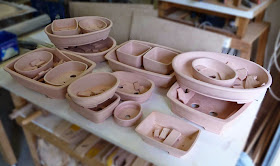These are the reamining 5 pots from my last firing; all with new glaze formulations from my last trial series.
The first two are from an oval mould with a slightly convex wall. The size is a useful intermediate scale.

The next three are also from the one (different) mould. They show how a slump mould can be used as a basis with different wall profiles to create slightly different pots. In Post 172 I showed a new bowed wall rectangular shaped pot, with less bow in the walls and more squared corners. These are the first three pots of that shape. Pot 27 shown in that post while still drying is now shown here, below, glazed.
The first one a quite assertive model with squared flange and lower rib as well as quite sharpish corners. Pot No 124 336 x 242 x 67
And then finally Pot No 123 with the more rounded corners. Pot No 123 325 x 240 x 67
Three different pots with slightly different characters from the same mould; from the more formal to the more relaxed.
The first two are from an oval mould with a slightly convex wall. The size is a useful intermediate scale.

Oval with rounded flange and lower rib Pot No125 313 x 245 x 62
Oval with squared flange Pot No 128 321 x 257 x 60
The next three are also from the one (different) mould. They show how a slump mould can be used as a basis with different wall profiles to create slightly different pots. In Post 172 I showed a new bowed wall rectangular shaped pot, with less bow in the walls and more squared corners. These are the first three pots of that shape. Pot 27 shown in that post while still drying is now shown here, below, glazed.
The first one a quite assertive model with squared flange and lower rib as well as quite sharpish corners. Pot No 124 336 x 242 x 67
This one has the same tight corners but no lower rib. It's Pot 127 from Post 172.
Pot No 127 340 x 250 x 72
And then finally Pot No 123 with the more rounded corners. Pot No 123 325 x 240 x 67
Three different pots with slightly different characters from the same mould; from the more formal to the more relaxed.

































 .
.





